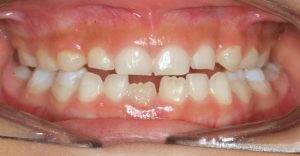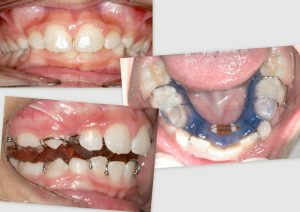Addressing the deficient vertical dimension
In Children Under The Age Of 6
A deep bite in very young children can be easily and significantly addressed without appliances or braces. A layer of composite is added over the primary molars to increase their height, hence adding to the vertical dimension. The permanent 6-year molars behind the primary molars will eventually erupt to the newly established vertical. The jawbone will likewise adapt through modified growth stimulated by the new bite position. This procedure does not address crowding, therefore appliance therapy may still be called for after age 6.
To learn more about this procedure, read the article Childhood Bite Opening…
In Children Ages 7-10
In cases with a collapsed vertical along with crowding, lower jaw appliances with a biting pad will allow the jaw to be functionally repositioned vertically, and at the same time will cause a lateral arch development to relieve crowding.
To read more on arch development, ideal intervention ages and techniques, visit the page Therapy Phases.
In Adults
In adults we cannot expect the main body of the jawbones to grow and modify in the same fashion as a growing child in response to functional procedures and appliances. Nevertheless, significant bone and joint remodeling still occurs upon intervention and braces, if forces are kept within the biological parameters of bone turnover. The TMJ (jaw-joint) is the first entity to suffer due to a collapsed vertical dimension, and also the first entity to respond favorably to a jaw repositioning. Precisely for this reason it is imperative to reposition the jaw and increase the vertical in collapsed bites.
The sequence involves the following:
- PHASE I: A temporary bite opening for 2-3 months, during which the jaw joint and the muscles functionally adapt to the new position and symptoms are monitored. This phase usually involves daytime and nighttime orthotics, and is reversible. We graduate to the next and permanent phase only if the jaws respond favorably.
- PHASE II: The teeth are moved (with braces) or built up (with porcelain overlays or onlays) to the new position determined by the orthotics.
To read more about how the bite collapses and details about this procedure, read the blog articles on
Continue to Braces – Straightwire Technique…




